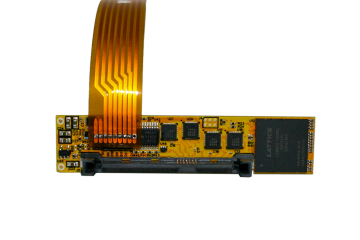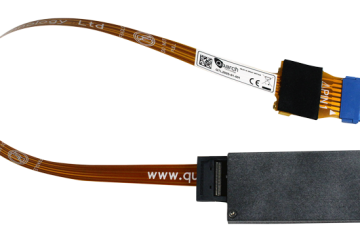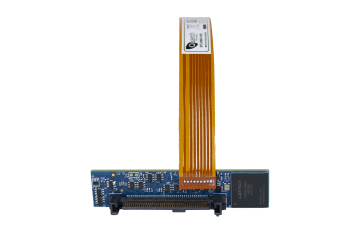
Andy Norrie
3 Reasons for testing pin-bounce with hot-swap
Pin bounce, or contact bounce, is an effect seen when plugging or removing a connector. Instead of transitioning from disconnected to connected cleanly, we see a ‘bounce’. It can cause a real headache if your system is not ready for it.

Here is a scope shot of pin-bounce (also known as contact-bounce), captured using a 2.5” SFF drive bay. This example is actually a drive ‘pull’, as bounce can happen in both directions. 5 transitions occur instead of just 1, with a bounce duration of between 10 to 40uS.
Pin-bounce can occur at any time the connector is ‘moving’ during the plug/pull process. As the metal connectors move across each other, friction and play in the connector can cause them to ‘bounce’. This causes intermittent connection between the pins.
If the plug duration takes 50mS (which is a common figure), then the bounce could occur during any/all of that period. Pin-bounce greatly increases the number of scenarios of how pins connect during a hot-plug, and each scenario can have a different effect on your system.
Each connector type will behave differently, and individual pins in the connector will also perform differently depending on their physical characteristics. Even individual plug cycles can be very different, depending on the speed you move at and the exact angle of the connector.
Why take time testing pin-bounce?
Bounce greatly increases the complexity of the system during hot-swap and creates a far larger matrix of things that can go wrong and so needs testing.
-
Power rail bounce: What happens if a power rail or pre-charge pin bounces?
The PMIC (Power Management IC) or hot-swap controller on the device may get confused. With power rails changing state very quickly, the control circuits may be under a lot more load than expected (risking early failure) or may simply fail to bring the drive up correctly. -
Sideband bounce: What if a sideband signal bounces?
Sidebands such as DUALPORT_EN are sampled at a specific point in the power-up; if the DUALPORT pin was bouncing during the plug sequence, it could be read as the opposite state, leading to a misconfiguration of the system. -
Overall sequencing: Many connectors use different pin lengths to set an expected plug sequence. Pin-bounce can throw this off, creating a scenario where a long pin (which would normally connect early) appears to connect later. This can throw off design assumptions about what order events will occur in.
Each of these cases can lead to failures. When developing products that rely on hot-plug (new CXL devices for example), it is critical that you have tested all these corner cases. Failing to do this early can risk products reaching market than can fail, creating support cases and damaging your reputation.
How can I test this?
Check out our white paper on hot-plug testing for more details:
Hot-swap testing white paper | HDDs, SSDs and beyond
If you are not ready to implement automated tests yourself, then check out Quarch Compliance Suite (QCS). It includes a set of tests for hot-swap and pin bounce timing that aim to capture many common problems.




